2. 甘肃省黄河水环境重点实验室, 兰州 730070;
3. 甘肃省污水处理行业技术中心, 兰州 730070
2. Key Laboratory of Yellow River Water Environment in Gansu Province, Lanzhou 730070, China;
3. Technical Center of Sewage Treatment Industry in Gansu, Lanzhou 730070, China
部分亚硝化-厌氧氨氧化(partial nitritation-anaerobic ammonium oxidation, PN/A)作为一种新型深度脱氮工艺具有效率高、能耗低和污泥产率低等优点, 受到广泛关注[1~3]. PN/A工艺是指部分亚硝化(PN)和厌氧氨氧化(ANAMMOX)反应分别在两个反应器中进行.在SBR反应器中, 氨氧化菌(AOB)将原水中约50%~60%的NH4+-N转化为NO2--N, 然后将其出水进入ASBR反应器, 在厌氧氨氧化菌(AnAOB)的作用下, 把NH4+-N和NO2--N转化为N2, 其化学反应式如下[4]:

|
近年来, PN/A工艺在高温条件下, 成功应用于养殖业废水[5]、消化上清液[6]和垃圾渗滤液[7]等高NH4+-N(>500mg·L-1)和低C/N(< 0.5)废水处理中, 但该工艺在处理城市生活污水方面研究非常局限[8].城市生活污水由于NH4+-N浓度低, 低NH4+-N条件下难以控制游离氨(FA)和游离亚硝酸(FNA)等不利因素易导致NOB富集, 使PN段出水硝酸盐增加, 难以为ANAMMOX提供稳定NO2--N[9]; 另外城市生活污水水温受季节性影响较大[10], NOB相比AOB对温度敏感性更强, AnAOB活性随温度下降减幅明显, 因此常低温下如何抑制NOB并提高AnAOB活性是PN/A工艺稳定运行的关键[11].陈亚等[12]的研究表明部分亚硝化的稳定运行对ANAMMOX影响较大; Miao等[13]的研究在(30±1)℃成功启动部分亚硝化系统; Yuan等[14]的研究采用进水NH4+-N浓度为50mg·L-1时, 一体式部分硝化厌氧氨氧化(single-stage of partial nitrification and anaerobic ammonium oxidation, SPN/A)工艺耦合反硝化工艺脱氮效果较好, TN去除率为83.50%.
以上研究均在温度较高条件下进行或采用模拟废水, 在处理实际城市生活污水时, 由于SPN/A工艺启动时间长、运行不稳定、微生物关系复杂和前端需特设除碳装置以避免对系统的冲击[15], 而PN/A工艺很好地解决了亚硝化和ANAMMOX污泥龄之间的矛盾[16], 利于控制运行参数, 具有可靠性高、启动时间短和脱氮效率高的优点[17], 另外可利用PN段出水中带入少量污泥和COD使异养菌进行反硝化产生CO2, 这为ANAMMOX协同反硝化脱氮除碳提供可能[18].因此, 本试验以城市生活污水为处理对象, 考察在常低温条件下缺氧/好氧时间比、交替次数、温度和C/N等因素对PN/A工艺部分亚硝化稳定实现和ANAMMOX协同反硝化同步脱氮除碳的影响, 以期为该工艺的实际应用提供理论参考.
1 材料与方法 1.1 试验装置PN/A工艺如图 1所示, SBR由有机玻璃所制, 直径15 cm, 高40 cm, 有效容积5 L, 侧壁设取样口, 配有搅拌装置, 通过PLC控制器检测pH、ORP及调节温度, 利用时间继电器实现间歇曝气; ASBR主体材质同SBR, 有效容积5 L, 顶部设通气口, 反应产生气体由水封瓶收集后排出, 另设缓冲瓶调节pH, 外壁由锡纸包裹避光.

|
图 1 PN/A工艺装置示意 Fig. 1 Schematic diagram of PN/A process device |
SBR接种污泥来自实验室稳定短程硝化污泥, MLSS为3 450 mg·L-1, MLVSS/MLSS(f值)为0.59, SV30为42%; ASBR接种污泥来自稳定运行的厌氧氨氧化反应器, MLSS为3 321 mg·L-1, VSS为2 514 mg·L-1, 脱氮性能良好.
1.3 试验进水水质及检测方法试验用水来自兰州交通大学家属区实际生活污水, SBR水质指标如表 1, 前置SBR反应器实现稳定部分亚硝化后通过加入NaNO2调节ASBR进水C/N, 具体进水水质见表 2.
|
|
表 1 SBR进水水质/mg·L-1 Table 1 Qualities of influent in the SBR/mg·L-1 |
|
|
表 2 ASBR进水水质(均值) Table 2 Average quantities of influent in the ASBR |
水样经0.45 μm孔径定性滤纸过滤后根据APHA标准方法[19]测定, COD: 快速消解分光光度法; NH4+-N: 纳氏试剂分光光度法; NO2--N: N-(1-萘基)-乙二胺分光光度法; NO3--N: 麝香草酚分光光度法; MLSS和VSS: 重量法; SV30和SVI: 30 min沉降法; 温度、pH和DO: 便携式测定仪.
1.4 运行策略SBR采用间歇运行, 1 d运行6个周期, 单周期240 min, 即进水5 min→反应180 min→沉淀30 min→排水5 min→闲置20 min, 调节曝气量为100 L·h-1, 排水比为75%.采用2种工况, 工况Ⅰ在25℃下, 采用缺氧/好氧时间比为30 min∶60 min、45 min∶45 min、30 min∶30 min, 分别交替2、2、3次; 工况Ⅱ采用缺氧/好氧时间比为30 min∶30 min交替3次, 调整温度分别为15、25和30℃. ASBR采用间歇运行, HRT为24 h, 排水比为70%, 控制温度为25℃, 调整C/N为2.5、2.0及1.5, 运行80 d.
1.5 计算方法NH4+-N去除率(ARE)、NO2--N积累率(NiAR)、比氨氮氧化速率(SAOR)、比亚硝态氮产生速率(SNiPR)和比硝态氮产生速率(SNaPR)等计算参考文献[20]的公式.ASBR内各级反应脱氮贡献率计算参考文献[21]的公式.
ASBR内各级反应脱氮贡献率计算:

|
(1) |

|
(2) |

|
(3) |

|
(4) |
式中, A、PN、PD和D分别为: ANAMMOX、部分硝化-ANAMMOX、部分反硝化-ANAMMOX和反硝化反应的脱氮贡献率, %; a、b和c分别为: NH4+-N消耗量、NO2--N消耗量和NO3--N产生量, mg·L-1.
1.6 物料衡算分析通过物料衡算可得不同间歇模式下SBR部分亚硝化过程中的氮损失(ΔTN, mg·L-1)、碳损失(ΔCOD, mg·L-1)和同步硝化反硝化碳氮比例(ΔCOD/ΔTN)[22]:

|
(5) |

|
(6) |

|
(7) |
式中, cn(TN)in和cn(TN)eff分别为第n周期进、出水TN浓度, cn-1(TN)eff为第n-1周期出水TN浓度, 单位均为mg·L-1; cn(COD)in和cn(COD)eff分别为第n周期进、出水COD浓度, cn-1(COD)eff为第n-1周期出水COD浓度, 单位均为mg·L-1; w为排水比.
2 结果与讨论 2.1 缺氧/好氧时间比对实现部分亚硝化的影响 2.1.1 缺氧/好氧时间比下NH4+-N及SAOR变化特征如图 2, 缺氧/好氧时间比为30 min∶60 min(A模式)、45 min∶45 min(B模式)和30 min∶30 min(C模式)中, 进水NH4+-N浓度均维持在49.47~101.22mg·L-1, ARE分别于第42、39及25周期达到稳定, 出水NH4+-N浓度分别为15.85、34.26和38.35mg·L-1, ARE分别为72.55%、54.46%和58.52%, 3种模式均能实现较稳定的部分亚硝化.C模式NO2--N积累高效稳定, 原因为试验接种污泥为短程硝化污泥, A、B模式相比, 好氧段时间减少不利于NH4+-N的去除, 缺氧段时间增加使NO2--N被还原量增加, 相对延长了NO2--N高效积累的时间, 故B模式较A模式所需时间长; A、C模式相比, 可能停曝频率变大有利于筛选出氨氧化速率较快的AOB及相对减少NOB的数量, 缩短C模式稳定部分亚硝化实现的时间.从SAOR来看, AOB生物量的提高表明交替缺氧/好氧环境下有利于AOB提高自身产率系数来加快生长繁殖[23], SAOR分别在45、36和16周期时达到稳定, 其中C模式增长幅度较快, 反应结束时SAOR分别为0.30、0.31和0.43g·(g·d)-1.与刘宏等[24]的研究相比, 本试验通过低曝气频率方式实现稳定部分亚硝化的时间更短, 节省能耗.

|
(a)30 min∶60 min(A模式), (b)45 min∶45 min(B模式), (c)30 min∶30 min(C模式) 图 2 缺氧/好氧时间比下NH4+-N和SAOR变化特征 Fig. 2 Characteristics of changes in NH4+-N and SAOR under different anoxic/aerobic time ratios |
如图 3, 3种模式进水NO2--N浓度均在1mg·L-1以下, 出水NO2--N浓度和NiAR均呈上升趋势, NiAR分别于第39、38和22周期稳定至97.87%、94.01%和98.06%, 出水NO2--N浓度分别增至24.00、19.82和25.92mg·L-1; SNiPR分别稳定至0.16、0.18和0.28g·(g·d)-1; 出水NO3--N浓度均随NOB减少而降低, 反应结束时SNaPR分别为0.001、0.007和0.002g·(g·d)-1, 出水NO3--N浓度分别降至0.22、1.00和0.20mg·L-1.
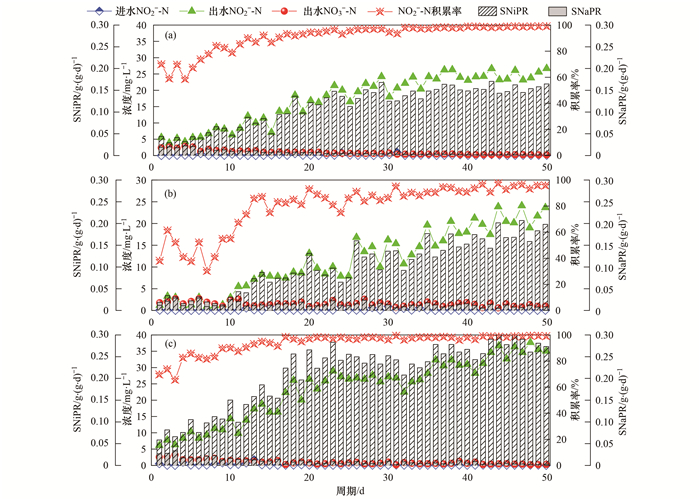
|
(a)30 min∶60 min(A模式), (b)45 min∶45 min(B模式), (c)30 min∶30 min(C模式) 图 3 缺氧/好氧时间比下NO2--N积累及SNaPR和SNiPR变化特征 Fig. 3 NO2--N accumulation and changes in SNaPR and SNiPR under different anoxic/aerobic time ratios |
张立成等[25]的研究认为NiAR在50%以上便实现了部分亚硝化, 刘宏[26]的研究采用交替好氧/缺氧模式第39周期才实现NO2--N稳定积累, 由于NOB为优势菌种, 采用交替好氧/缺氧模式, 在有机碳源充足的情况下, 好氧段产生的NO2--N短时间内易被氧化为NO3--N, 较交替缺氧/好氧模式更不易控制; 若先进行缺氧反应, 因为AOB“饱食饥饿”特性使其更易富集, 张杰等[27]的研究采用停曝比为1∶1并协同其它控制条件的方式实现了部分亚硝化稳定运行, 阶段末NiAR为85.20%.相比连续曝气, 间歇曝气具有碱度投加量少、效率高及避免碳源不足等优点.但匹配ANAMMOX的部分亚硝化并非NO2--N浓度越高越好, 否则需外加铵盐或引入新鲜污水调节基质浓度及比值, 导致处理成本增加、系统崩溃.本试验中C模式实现稳定部分亚硝化最快, 利于降低成本.
2.1.3 缺氧/好氧时间比下ΔTN及ΔCOD如图 4, 由式(5)~(7)可得不同模式氮损失(ΔTN)、碳损失(ΔCOD)和ΔCOD/ΔTN, 忽略内源反硝化与细胞同化作用, 则ΔTN为同步硝化反硝化作用消耗TN. 3种模式下初始ΔTN和ΔCOD分别为1.69、2.43、3.32mg·L-1和42.70、34.39、36.38mg·L-1, 周期末ΔTN和ΔCOD分别稳定至23.60、14.50、12.29mg·L-1和138.54、104.17、110.36mg·L-1, ΔCOD/ΔTN稳定至5.87、7.18和8.98.可见3种模式下均发生了氮损失, 主要原因为[28, 29]: ①反应器存在局部环境DO分布不均; ②活性污泥絮体由于氧传递受限, DO浓度从表面至内部降低; ③存在好氧反硝化菌和异养硝化菌, 为同步硝化反硝化提供了有利条件.A模式下发生同步硝化反硝化所需碳源最多, 但B模式下消耗碳源最少, 可能因为A模式下好氧段相对较长, 使其积累的NO2--N被氧化为NO3--N, 为缺氧段反硝化提供充足的基质, 导致ΔCOD最大, C模式下交替次数的上升有利于COD的去除, 故好氧段的长短和交替次数决定有机碳源的消耗量, 好氧段越长发生同步硝化反硝化所消耗有机碳源越多, 其ΔTN也最大[30]. ΔCOD/ΔTN可作为该模式的理论依据, 以寻求在相对较少的ΔTN下获得较大的ΔCOD, 避免ASBR中COD过高对ANAMMOX产生不利影响.
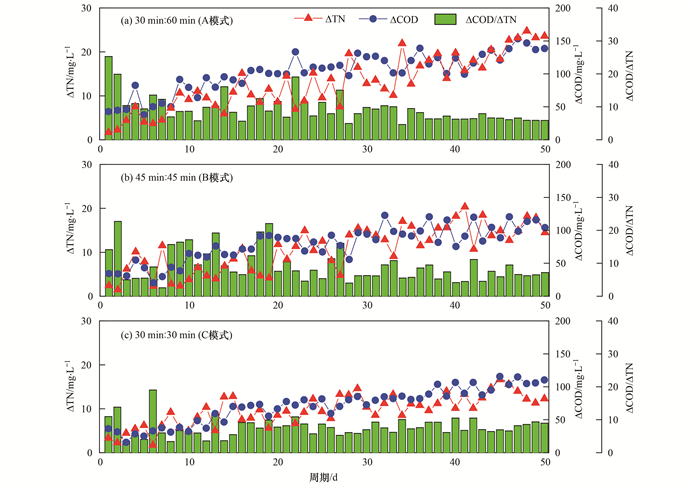
|
图 4 缺氧/好氧时间比下ΔTN及ΔCOD变化特征 Fig. 4 Characteristics of changes in ΔTN and ΔCOD under different anoxic/aerobic time ratios |
保持缺氧/好氧时间比为30 min∶30 min, 如图 5, 15、25和30℃时, 出水NH4+-N浓度、ARE和SAOR分别为47.50mg·L-1、45.63%、0.38g·(g·d)-1、31.58mg·L-1、60.27%、0.47g·(g·d)-1和4.12mg·L-1、95.35%、0.81g·(g·d)-1.可见一定范围内, 温度越高SAOR越大, ARE越高, 主要因为高温有利于AOB的繁殖, 但高温下系统易失稳转向短程硝化, 不能为ANAMMOX提供合适的基质浓度[31]. 30℃时部分亚硝化系统已失稳转化为短程硝化.

|
图 5 不同温度下NH4+-N及SAOR变化特征 Fig. 5 Characteristics of NH4+-N and SAOR changes at different temperatures |
如图 6, 15℃时, NiAR波动较大, 出水NO2--N浓度、NiAR和SNiPR分别低至14.05mg·L-1、34.99%和0.12g·(g·d)-1, 而NO3--N浓度和SNaPR居高不下, 可见低温下难以实现部分亚硝化.从15℃上升至30℃, NO2--N浓度、NiAR和SNiPR均明显增大, 说明温度上升有利于NO2--N的积累, 这与Jia等[32]的研究结果相同.Paredes等[33]的研究发现当温度高于15℃, AOB活性及繁殖速率大于NOB, 25℃以上时这一趋势更加明显, 这与本试验的结果一致.如图 7, f和SVI是影响NO2--N稳定积累的重要参数. 3种温度下初始f和SVI(mL·g-1)分别为0.42、0.48、0.45和48.73、65.53、58.06, 各f和SVI值均先上升, 达到稳定分别需36、15和29 d.结束时f和SVI(mL·g-1)分别为0.61、0.79、0.81和126.88、93.17、89.98, 30℃下f增速最快, 15℃下SVI在36 d达到最大值130.46 mL·g-1, 低温环境AOB活性降低, 丝状菌大量繁殖导致污泥膨胀, 伴随污泥上浮现象.而25℃和30℃下SVI稳定在90 mL·g-1左右, 污泥活性和沉降性较好, 说明污泥性能随温度上升而提高.从耗能角度看25℃更适宜匹配ANAMMOX.

|
图 6 不同温度下NO2--N积累及SNaPR、SNiPR变化特征 Fig. 6 NO2--N accumulation and SNaPR, SNiPR change characteristics at different temperatures |
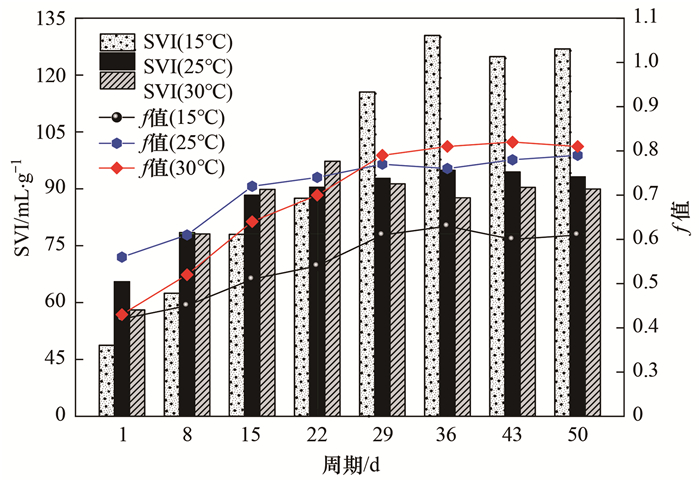
|
图 7 不同温度下SBR污泥性能变化特征 Fig. 7 Characteristics of SBR sludge performance changes at different temperatures |
如图 8, 组合工艺进水TN、NH4+-N和COD浓度均值分别为77.68、75.96和281.07mg·L-1, 出水TN、NH4+-N和COD浓度稳定在13.13、4.83和69.96mg·L-1, 去除率分别为83.10%、93.64%和75.11%, 脱氮效果较好.普遍认为匹配ANAMMOX的基质比NO2--N/NH4+-N在1∶1左右即可[34], 但本试验出水NH4+-N有剩余, 且发现在SBR出水COD均值为113.05mg·L-1下, 组合工艺出水NO3--N稳定在7.46mg·L-1, 说明ASBR中反硝化作用微弱, 导致除碳效果不理想, 有研究表明有机物浓度在150mg·L-1以下AnAOB可以和反硝化菌共存[35], 且有机物对AnAOB具有双向作用[36], 是否在较低有机物浓度下NO2--N的量决定了ANAMMOX协同反硝化脱氮除碳的进程, 故通过投加亚硝酸钠调节C/N对两者协同性能作近一步考察.
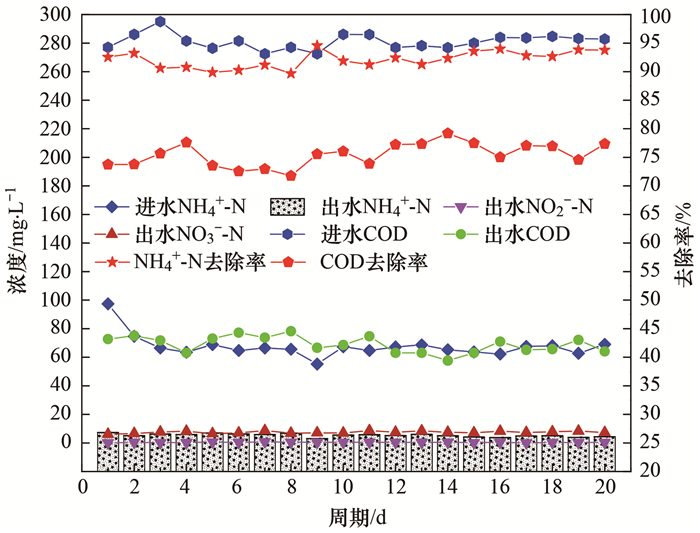
|
图 8 SBR-ASBR组合工艺处理生活污水效果 Fig. 8 Treatment effect of the SBR-ASBR combined process on domestic sewage |
ASBR进水来自SBR出水, 其进水COD和NO2--N分别稳定在113.05和37.48mg·L-1左右, 投加NaNO2调整ASBR进水C/N分别为2.5、2.0和1.5.如图 9, C/N为3.0是SBR-ASBR组合工艺处理实际生活污水ASBR段效果, C/N从3.0降至2.0时, ARE和COD去除率均呈上升趋势, C/N降至1.5时, ARE下降, 而COD去除率保持稳定.C/N的变化对NO2--N的去除影响较小, 其去除率接近100%.C/N从3.0降低到1.5过程中, 出水NO3--N浓度由7.29mg·L-1降至0.22mg·L-1.
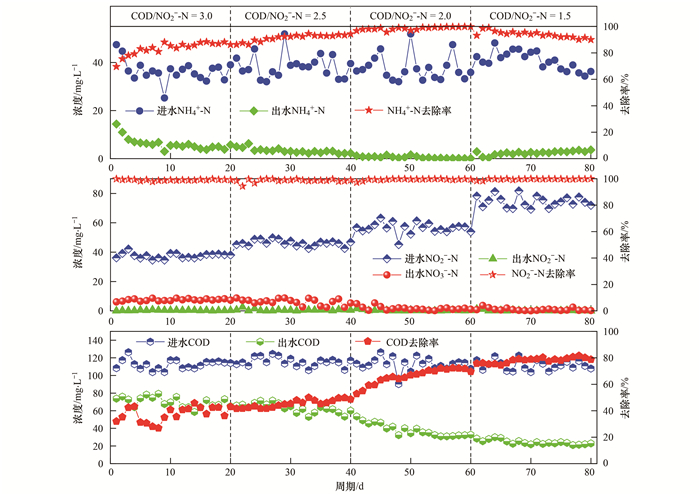
|
图 9 不同C/N下ASBR氮素和COD变化特征 Fig. 9 Variation characteristics of nitrogen and COD during anaerobic ammoxidation under different C/N |
C/N为3.0时, 试验初期菌体处于内源呼吸期, AnAOB对基质需求迫切, 增加的NO2--N使AnAOB得到相对充足的电子受体, 但NO2--N量不足使AnAOB难以继续与剩余NH4+-N进行ANAMMOX, 异养菌反应微弱, 对COD去除率不高[37]; C/N为2.0时, 微过量的NO2--N为ANAMMOX和异养反硝化菌提供充足基质, 反硝化菌为AnAOB解除了氧毒[38], 促进ANAMMOX和反硝化反应, 出水NH4+-N、NO3--N、COD浓度减幅明显; C/N为1.5时, ANAMMOX取决于NH4+-N的量, 剩余NO2--N和ANAMMOX生成的NO3--N为反硝化菌提供充足的基质, 使脱氮性能变差.
C/N降低过程中, NO2--N浓度逐渐增大, 以ANAMMOX为主协同反硝化脱氮除碳作用逐渐增强; C/N < 2.0时, AnAOB竞争优势减弱, 系统内以反硝化为主, 协同性能下降.可见C/N是决定ANAMMOX协同反硝化的重要因素[39], 马艳红等[40]的研究发现适当的COD浓度可以增强ANAMMOX协同反硝化的效果; 王凡等[41]的研究处理模拟废水在C/N为0.4时AnAOB和反硝化菌协同能力最强.本试验C/N为2.0时系统协同性能最佳, 出水NH4+-N、NO2--N、NO3--N和COD分别为0.09、0.25、1.04和32.73mg·L-1.
2.4.2 不同C/N下脱氮贡献率和化学计量比变化特征如图 10, 整个过程中, 全程反硝化脱氮占比逐渐增大.C/N为3.0系统脱氮贡献主要由ANAMMOX、部分反硝化和全程反硝化提供, ANAMMOX平均脱氮贡献率达89.64%, 部分反硝化-ANAMMOX和全程反硝化平均脱氮贡献率共计7.03%, NO2--N不足使系统部分反硝化-ANAMMOX占比较全程反硝化大, 另外系统内存在少量氮循环菌属参与其它脱氮途径; C/N为2.5 ANAMMOX脱氮贡献率相对稳定, 部分亚硝化和部分反硝化脱氮贡献率降低, 全程反硝化脱氮贡献率增至10.30%; C/N为2.0 ANAMMOX平均脱氮贡献率降至77.98%, 而全程反硝化增至21.16%, 可见C/N由3.0降至2.0过程中, 系统ANAMMOX协同反硝化作用增至最大, 脱氮性能上升; C/N降至1.5后, ANAMMOX平均脱氮贡献率降至49.72%, 反硝化菌逐渐占据优势, 这与Zhang等[42]的研究结果一致.
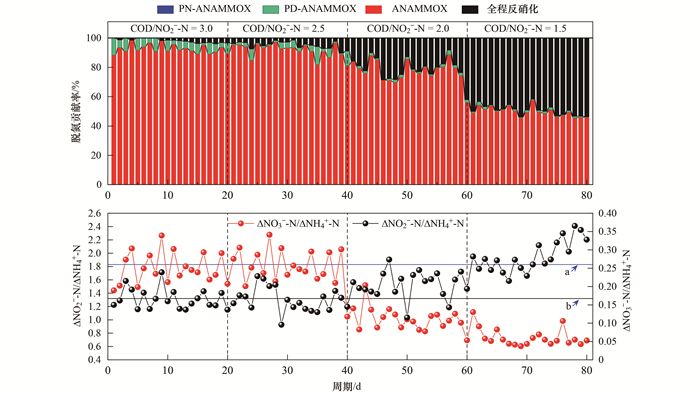
|
a.ΔNO3--N/ΔNH4+-N理论值0.26, b.ΔNO2--N/ΔNH4+-N理论值1.32 图 10 不同C/N下脱氮贡献率和化学计量比变化特征 Fig. 10 Variation characteristics of nitrogen removal contribution ratio and stoichiometric ratio under different C/N |
C/N为3.0和2.5时, ΔNO2--N/ΔNH4+-N和ΔNO3--N/ΔNH4+-N分别在其理论值附近波动, 且均值略低于理论值, 因为在ANAMMOX为主反应的前提下, 硝化、反硝化等氮循环菌属少量协同脱氮, 且ASBR中存在少量的AOB和DO易造成实际比值低于理论值[43]; C/N为2.0, 微过量的NO2--N促进了反硝化菌繁殖, NH4+-N浓度相对不足, 造成ΔNO2--N/ΔNH4+-N高于理论值, 反硝化脱氮贡献率增大, 造成ΔNO3--N/ΔNH4+-N进一步偏低, C/N为1.5时这一趋势更加明显, 不利于AnAOB协同其它菌属脱氮.
目前多探究ANAMMOX协同反硝化进水有机物的阈值, 有关COD对ANAMMOX系统微生物的影响尚无确切定论[44, 45], 且添加COD易造成反硝化菌大量繁殖, 不易控制, 本试验在ASBR进水COD均值为113.05mg·L-1下, 发现NO2--N的量决定了ANAMMOX协同反硝化脱氮除碳的程度.
3 结论(1) 当温度为25℃, 缺氧/好氧时间比为30 min∶30 min, 交替次数为3时, 实现高效稳定亚硝积累时间最短, SBR部分亚硝化中ARE、NiAR和出水NO2--N浓度分别为60.27%、99.38%和35.04mg·L-1.
(2) 不同缺氧/好氧时间比下易发生同步硝化反硝化现象, 好氧段的长短决定有机碳源的消耗量, 从而影响同步硝化反硝化氮损失.缺氧/好氧时间比分别为30 min∶60 min、45 min∶45 min和30 min∶30 min时, ΔTN和ΔCOD分别稳定至23.60, 14.50、12.29mg·L-1和138.54、104.17、110.36mg·L-1, 缺氧/好氧时间比为30 min∶30 min下消耗COD较多的同时因同步硝化反硝化发生的氮损失最少.
(3) 组合工艺脱氮性能良好, 出水TN、NH4+-N和COD浓度分别稳定在13.13、4.83和69.96mg·L-1, 去除率分别为83.10%、93.64%和75.11%.ASBR进水COD为113.05mg·L-1下, NO2--N的量决定了ANAMMOX协同反硝化脱氮除碳的效果, 当C/N为2.0协同性能最佳, 出水NH4+-N、NO2--N、NO3--N和COD浓度分别为0.09、0.25、1.04和32.73mg·L-1.
| [1] | Liu T, Hu S H, Yuan Z G, et al. High-level nitrogen removal by simultaneous partial nitritation, anammox and nitrite/nitrate-dependent anaerobic methane oxidation[J]. Water Research, 2019, 166. DOI:10.1016/j.watres.2019.115057 |
| [2] | Wu L N, Yan Z B, Huang S, et al. Rapid start-up and stable maintenance of partial nitrification-anaerobic ammonium oxidation treatment of landfill leachate at low temperatures[J]. Environmental Research, 2020, 191. DOI:10.1016/j.envres.2020.110131 |
| [3] | Han X Y, Zhang S J, Yang S H, et al. Full-scale partial nitritation/anammox(PN/A)process for treating sludge dewatering liquor from anaerobic digestion after thermal hydrolysis[J]. Bioresource Technology, 2020, 297. DOI:10.1016/j.biortech.2019.122380 |
| [4] | Sui Q W, Di F, Zhang J Y, et al. Advanced nitrogen removal in a fixed-bed anaerobic ammonia oxidation reactor following an anoxic/oxic reactor: nitrogen removal contributions and mechanisms[J]. Bioresource Technology, 2021, 320. DOI:10.1016/j.biortech.2020.124297 |
| [5] | Pan Z Z, Dai R Z, Liao J S, et al. Spontaneous formation and mechanism of anaerobic ammonium oxidation(anammox)bacteria in swine wastewater treatment system[J]. International Biodeterioration & Biodegradation, 2020, 154. DOI:10.1016/j.ibiod.2020.105058 |
| [6] | Zhou X, Zhang Z Q, Zhang X A, et al. A novel single-stage process integrating simultaneous COD oxidation, partial nitritation-denitritation and anammox(SCONDA)for treating ammonia-rich organic wastewater[J]. Bioresource Technology, 2018, 254: 50-55. DOI:10.1016/j.biortech.2018.01.057 |
| [7] | Lin Z Y, Xu F Y, Wang Y M, et al. Autotrophic nitrogen removal by partial nitrification-anammox process in two-stage sequencing batch constructed wetlands for low-strength ammonium wastewater[J]. Journal of Water Process Engineering, 2020, 38. DOI:10.1016/j.jwpe.2020.101625 |
| [8] | Deng S Y, Peng Y Z, Zhang L, et al. Advanced nitrogen removal from municipal wastewater via two-stage partial nitrification-simultaneous anammox and denitrification(PN-SAD)process[J]. Bioresource Technology, 2020, 304. DOI:10.1016/j.biortech.2020.122955 |
| [9] |
王思萌, 苗圆圆, 彭永臻. 低温投加短程硝化污泥下城市污水SPN/A工艺运行特性[J]. 中国环境科学, 2019, 39(4): 1456-1463. Wang S M, Miao Y Y, Peng Y Z. Operation characteristics of the SPN/A process for municipal wastewater under low temperature shortcut nitrification sludge[J]. China Environmental Science, 2019, 39(4): 1456-1463. DOI:10.3969/j.issn.1000-6923.2019.04.013 |
| [10] | Cao Y S, Van Loosdrecht M C M, Daigger G T. Mainstream partial nitritation-anammox in municipal wastewater treatment: status, bottlenecks, and further studies[J]. Applied Microbiology and Biotechnology, 2017, 101(4): 1365-1383. DOI:10.1007/s00253-016-8058-7 |
| [11] | Gao D W, Xiang T. Deammonification process in municipal wastewater treatment: challenges and perspectives[J]. Bioresource Technology, 2021, 320. DOI:10.1016/j.biortech.2020.124420 |
| [12] |
陈亚, 印雯, 张星星, 等. 反硝化除磷耦合部分亚硝化-厌氧氨氧化一体式工艺的启动[J]. 环境科学, 2020, 41(5): 2367-2372. Chen Y, Yin W, Zhang X X, et al. Start-up of an integrated process of denitrifying phosphorus removal coupled with partial nitritation and anaerobic ammonium oxidation[J]. Environmental Science, 2020, 41(5): 2367-2372. |
| [13] | Miao J, Yin Q D, Hori T, et al. Nitrifiers activity and community characteristics under stress conditions in partial nitrification systems treating ammonium-rich wastewater[J]. Journal of Environmental Sciences, 2018, 73: 1-8. DOI:10.1016/j.jes.2017.12.020 |
| [14] | Yuan Y, Li X, Li B L. Autotrophic nitrogen removal characteristics of PN-anammox process enhanced by sulfur autotrophic denitrification under mainstream conditions[J]. Bioresource Technology, 2020, 316. DOI:10.1016/j.biortech.2020.123926 |
| [15] | Chen Y Z, Zhao Z C, Liu H, et al. Achieving stable two-stage mainstream partial-nitrification/anammox(PN/A)operation via intermittent aeration[J]. Chemosphere, 2020, 245. DOI:10.1016/j.chemosphere.2019.125650 |
| [16] |
姜黎安, 隋倩雯, 徐东耀, 等. 部分亚硝化-厌氧氨氧化工艺处理低氨氮废水研究进展[J]. 环境工程, 2019, 37(1): 61-66. Jiang L A, Sui Q W, Xu D Y, et al. Research progress on treatment of low ammonia nitrogen wastewater by partial nitrification-anammox process[J]. Environmental Engineering, 2019, 37(1): 61-66. |
| [17] | Sharp R, Khunjar W, Daly D, et al. Nitrogen removal from water resource recovery facilities using partial nitrification, denitratation-anaerobic ammonia oxidation(PANDA)[J]. Science of the Total Environment, 2020, 724. DOI:10.1016/j.scitotenv.2020.138283 |
| [18] | Yan J, Wang S J, Wu L Y, et al. Long-term ammonia gas biofiltration through simultaneous nitrification, anammox and denitrification process with limited N2O emission and negligible leachate production[J]. Journal of Cleaner Production, 2020, 270. DOI:10.1016/j.jclepro.2020.122406 |
| [19] | APHA. Standard methods for the Examination of water and wastewater(21st ed. )[M]. Washington, DC: American Public Health Association, 2005. |
| [20] |
孙洪伟, 吕心涛, 魏雪芬, 等. 游离氨(FA)耦合曝气时间对硝化菌活性的抑制影响[J]. 环境科学, 2016, 37(3): 1075-1081. Sun H W, Lü X T, Wei X F, et al. Synergetic inhibitory effect of free ammonia and aeration phase length control on the activity of nitrifying bacteria[J]. Environmental Science, 2016, 37(3): 1075-1081. |
| [21] |
曹雁. 厌氧氨氧化与反硝化协同脱氮及微生物特性研究[D]. 广州: 华南理工大学, 2018. Cao Y. Study on performance and microbial characteristics of co-existence of anammox and denitrification for simultaneous nitrogen removal[D]. Guangzhou: South China University of Technology, 2018. |
| [22] |
刘安迪, 赵凯亮, 刘宏, 等. 不同控制策略下短程硝化启动及运行工况优化[J]. 环境科学, 2019, 40(10): 4569-4577. Liu A D, Zhao K L, Liu H, et al. Short-cut nitrification start-up and optimization of operating conditions under different control strategies[J]. Environmental Science, 2019, 40(10): 4569-4577. |
| [23] | Zheng Z M, Huang S, Bian W, et al. Enhanced nitrogen removal of the simultaneous partial nitrification, anammox and denitrification(SNAD)biofilm reactor for treating mainstream wastewater under low dissolved oxygen(DO)concentration[J]. Bioresource Technology, 2019, 283: 213-220. DOI:10.1016/j.biortech.2019.01.148 |
| [24] |
刘宏, 南彦斌, 李慧, 等. 间歇曝气模式下曝气量对短程硝化恢复的影响[J]. 环境科学, 2018, 39(2): 865-871. Liu H, Nan Y B, Li H, et al. Effect of aeration rate on shortcut nitrification recovery in intermittent aeration mode[J]. Environmental Science, 2018, 39(2): 865-871. |
| [25] |
张立成, 党维, 徐浩, 等. SBR快速实现短程硝化及影响因素[J]. 环境工程学报, 2015, 9(5): 2272-2276. Zhang L C, Dang W, Xu H, et al. Achievement and influencing factors of shortcut nitrification in SBR process[J]. Chinese Journal of Environmental Engineering, 2015, 9(5): 2272-2276. |
| [26] |
刘宏. 间歇曝气SBR完全短程硝化+ASBR厌氧氨氧化脱氮性能研究[D]. 兰州: 兰州交通大学, 2018. Liu H. Study on nitrogen removal performance using SBR complete shortcut nitrification under intermittent aeration+ASBR Anammox[D]. Lanzhou: Lanzhou Jiaotong University, 2018. |
| [27] |
张杰, 劳会妹, 李冬, 等. 不同停曝比对连续流亚硝化颗粒污泥运行的影响[J]. 环境科学, 2020, 41(11): 5097-5105. Zhang J, Lao H M, Li D, et al. Effect of different ratios of anaerobic time and aeration time on the operation of a continuous-flow reactor with partial nitrification granules[J]. Environmental Science, 2020, 41(11): 5097-5105. |
| [28] |
杨玉兵. 两段式短程硝化-厌氧氨氧化脱氮性能及其N2O产生途径研究[D]. 北京: 北京工业大学, 2018. Yang Y B. Two-stage partial nitrification-anaerobic ammonium oxidation denitrification performance and its N2O production pathway[D]. Beijing: Beijing University of Technology, 2018. |
| [29] |
冯亮, 袁春燕, 杨超, 等. 好氧反硝化生物脱氮技术的研究进展[J]. 微生物学通报, 2020, 47(10): 3342-3354. Feng L, Yuan C Y, Yang C, et al. Research progress in nitrogen removal by aerobic denitrification[J]. Microbiology China, 2020, 47(10): 3342-3354. |
| [30] |
赵智超, 黄剑明, 李健, 等. 间歇曝气连续流反应器同步硝化反硝化除磷[J]. 环境科学, 2019, 40(2): 799-807. Zhao Z C, Huang J M, Li J, et al. Simultaneous nitrification and denitrifying phosphorus removal in continuous flow reactor with intermittent aeration[J]. Environmental Science, 2019, 40(2): 799-807. |
| [31] | Xu Z Z, Zhang L, Gao X J, et al. Optimization of the intermittent aeration to improve the stability and flexibility of a mainstream hybrid partial nitrification-anammox system[J]. Chemosphere, 2020, 261. DOI:10.1016/j.chemosphere.2020.127670 |
| [32] | Jia W L, Chen Y F, Zhang J, et al. Response of greenhouse gas emissions and microbial community dynamics to temperature variation during partial nitrification[J]. Bioresource Technology, 2018, 261: 19-27. DOI:10.1016/j.biortech.2018.03.137 |
| [33] | Paredes D, Kuschk P, Mbwette T S A, et al. New aspects of microbial nitrogen transformations in the context of wastewater treatment-a review[J]. Engineering in Life Sciences, 2007, 7(1): 13-25. DOI:10.1002/elsc.200620170 |
| [34] | Dong H, Zhang K Y, Han X, et al. Achievement, performance and characteristics of microbial products in a partial nitrification sequencing batch reactor as a pretreatment for anaerobic ammonium oxidation[J]. Chemosphere, 2017, 183: 212-218. DOI:10.1016/j.chemosphere.2017.05.119 |
| [35] |
李田, 曹家炜, 谢凤莲, 等. ABR除碳-亚硝化耦合厌氧氨氧化处理城市污水[J]. 环境科学, 2019, 40(3): 1390-1395. Li T, Cao J W, Xie F L, et al. ABR decarbonization-nitrosation coupled with ANAMMOX to treat municipal wastewater[J]. Environmental Science, 2019, 40(3): 1390-1395. |
| [36] | Li J L, Li J W, Peng Y Z, et al. Insight into the impacts of organics on anammox and their potential linking to system performance of sewage partial nitrification-anammox(PN/A): a critical review[J]. Bioresource Technology, 2020, 300. DOI:10.1016/j.biortech.2019.122655 |
| [37] |
安芳娇, 黄剑明, 黄利, 等. 基质比对厌氧氨氧化耦合反硝化脱氮除碳的影响[J]. 环境科学, 2018, 39(11): 5058-5064. An F J, Huang J M, Huang L, et al. Effect of substrate ratio on removal of nitrogen and carbon using anaerobic ammonium oxidation and denitrification[J]. Environmental Science, 2018, 39(11): 5058-5064. |
| [38] |
童颖. 有机物对厌氧氨氧化双向影响及抑制解除[D]. 沈阳: 沈阳建筑大学, 2014. Tong Y. Two-way role of organic matter on anammox and inhibition[D]. Shenyang: Shenyang Jianzhu University, 2014. |
| [39] | Wang Z Z, Ji Y, Yan L N, et al. Simultaneous anammox and denitrification process shifted from the anammox process in response to C/N ratios: Performance, sludge granulation, and microbial community[J]. Journal of Bioscience and Bioengineering, 2020, 130(3): 319-326. DOI:10.1016/j.jbiosc.2020.04.007 |
| [40] |
马艳红, 赵智超, 安芳娇, 等. 不同COD浓度下低基质厌氧氨氧化的启动特征[J]. 环境科学, 2019, 40(5): 2317-2325. Ma Y H, Zhao Z C, An F J, et al. Start-up performance of low-substrate anaerobic ammonium oxidation under different COD concentrations[J]. Environmental Science, 2019, 40(5): 2317-2325. |
| [41] |
王凡, 刘凯, 林兴, 等. 不同TOC/NH4+-N对厌氧氨氧化脱氮效能的影响[J]. 环境科学, 2017, 38(8): 3415-3421. Wang F, Liu K, Lin X, et al. Effect of different TOC to NH4+-N ratios on nitrogen removal efficiency in the ANAMMOX process[J]. Environmental Science, 2017, 38(8): 3415-3421. |
| [42] | Zhang X Y, Liu Y, Li Z R, et al. Impact of COD/N on anammox granular sludge with different biological carriers[J]. Science of the Total Environment, 2020, 728. DOI:10.1016/j.scitotenv.2020.138557 |
| [43] |
刘安迪. 部分亚硝化耦合厌氧氨氧化脱氮除碳性能研究[D]. 兰州: 兰州交通大学, 2020. Liu A D. Experimental study on nitrogen and carbon removal performance of partial nitrification coupled with anaerobic ammonia oxidation[D]. Lanzhou: Lanzhou Jiaotong University, 2019. |
| [44] | Deng L Y, Peng Y Z, Li J W, et al. Enhanced simultaneous nitrogen and phosphorus removal from low COD/TIN domestic wastewater through nitritation-denitritation coupling improved anammox process with an optimal Anaerobic/Oxic/Anoxic strategy[J]. Bioresource Technology, 2021, 322. DOI:10.1016/J.biortech.2020.124526 |
| [45] | Pijuan M, Ribera-Guardia A, Balcázar J L, et al. Effect of COD on mainstream anammox: Evaluation of process performance, granule morphology and nitrous oxide production[J]. Science of the Total Environment, 2020, 712. DOI:10.1016/j.scitotenv.2019.136372 |
 2021, Vol. 42
2021, Vol. 42


